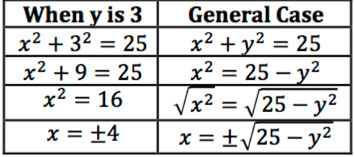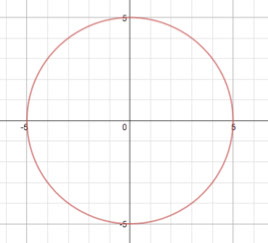Home
Episode 5 Supports
Episode Description
Reflecting: Sasha and Keoni share ideas about the usefulness of the equation x = √4y, which they derived in Episode 2.
Students’ Conceptual Challenges
Students might not notice the connection between the general equation and the earlier procedure they used several times to solve for the x value for a known y value of a point on the parabola.
When asked to find the x value of when y is 50, Keoni writes down the equation that represents the Pythagorean theorem. Sasha jokes with him that he likes the “long way.” Sasha is prompted to clarify what she means by the long way. Together they solve for x using both procedures, the Pythagorean theorem equation and the general equation, x = √(4y). They notice that they get the same answers.
Focus Questions
For use in a classroom, pause the video and ask these questions:
1. [Pause video at 2:27]. Sasha says “you just like the long way.” What does she mean by the long way?
2. [Pause video at 4:26].What do you think? Will Sasha’s method get the same answer? Why or why not?
Supporting Dialogue
Build on students’ responses to the question: “what does Sasha mean by the long way?” by asking:
- Kara can you repeat what Dan said about the long way?
- How about someone else? What do you think about what Keoni has written?
- Kara can you repeat what Dan said about the long way?
Math Extensions
The points on the circle below can be represented by equations. There are two possible representations in the table below.

1. What is the difference between the two representations? Solve for the x-value when the y-value is 1.5.
2. What is meant by the symbol ±? How does it relate to the shape of the circle?

Mathematics in this Lesson
Lesson Description
Targeted Understanding
CC Math Standards
CC Math Practices
Lesson Description
Keoni and Sasha create a general method for representing the x-value for any point on a particular parabola, given the y-value of that point. By using their previous results, along with the Pythagorean theorem, they are able to determine the equation for the parabola.
Targeted Understandings
This lesson can help students:
- Interpret the meaning and use of an equation that they derive to relate the x-value to the y-value for a general point on a given parabola (x = √(4y)).
- Conceive of algebraic symbols, such as x and y, as quantities that have infinitely many possible values and that vary together, rather than only as unknowns that have a single numerical value.
- Express important quantities, such as the distance between a general point on a given parabola and its directrix, by generalizing one’s reasoning from Lesson 2, when students determined the x-value for different points on the parabola when y was 5, 7 and 10.
Common Core Math Standards
• CCSS.M.HSG.GPE.A.2: Derive the equation of a parabola given a focus and directrix.
Sasha and Keoni use the definition of a parabola, along with the Pythagorean theorem, to derive the equation of a given parabola in Lesson 3. They express it in a form that is useful for locating the x-value for any point on the parabola given its y-value (namely, x = √(4y)). In Lesson 4, they re-express and derive the equation as y = x2/4 . Later, they generalize their reasoning to derive the equation for any parabola with vertex (0,0) in Lesson 5 and any parabola with vertex (h,k) in Lesson 9.
• CCSS.M.HSA.SSE.A.1.B. Interpret complicated expressions by viewing one or more of their parts as a single entity. Sasha and Keoni express the distance from a general point (x,y) on a particular parabola to its directrix (y = –1) as y + 1. They conceive of this distance as a single entity, which they locate on the graph. They are also able to describe and locate the distances represented by parts of the expression: y and 1. Similarly they interpret the expression y – 1 both as an entity and in terms of the distances represented by each of its parts.
Common Core Math Practices
CCSS.Math.Practice.MP2 Reason abstractly and quantitatively.
According to the Common Core’s description of Math Practice 2, mathematically proficient students are able to “decontextualize—to abstract a given situation and …manipulate the representing symbols as if they have a life of their own” and to “contextualize, to pause as needed during the manipulation process in order to probe into the referents for the symbols involved.” Sasha and Keoni use the Pythagorean theorem to set up the equation for a given parabola as (y–1)2 + x2 = (y–1)2 and then reason abstractly by performing appropriate algebraic transformations to arrive at the equation x = √(4y). However, they also reason quantitatively by describing the distances represented by each term in both equations: y–1, x, y+1, y, and √4y. They also discuss what the equation x = √(4y) means and how it is useful.















